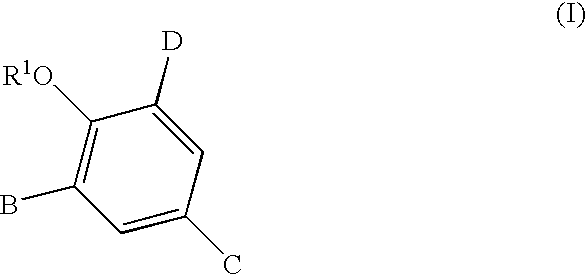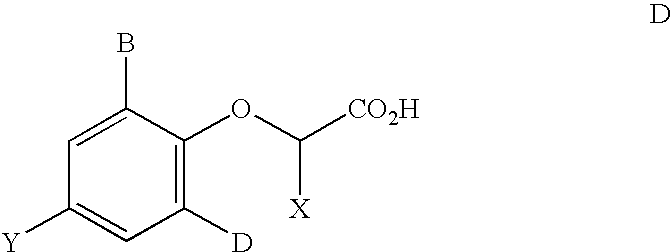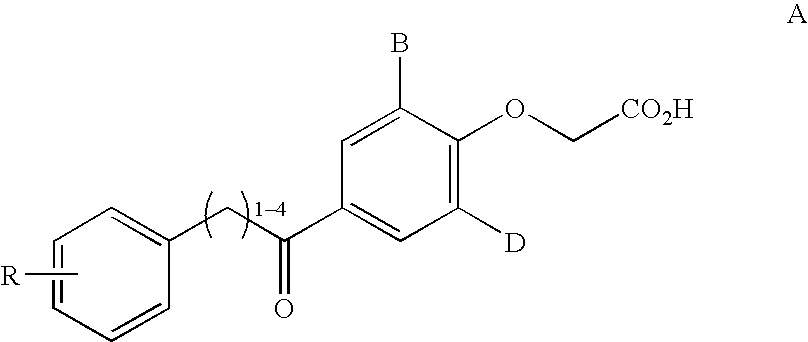2,3,5-substituted biphenyls useful in the treatment of insulin resistance and hyperglycemia
- Summary
- Abstract
- Description
- Claims
- Application Information
AI Technical Summary
Problems solved by technology
Method used
Image
Examples
example 1
(3,3″-Dichloro-5′-dodecylcarbamoyl-[1,1′;3′,1″]terphenyl-2′-yloxy)-acetic acid
Step 1 3,5-Bis-(3-chlorophenyl)-4-(2-hydroxyethoxy)benzoic acid ethyl ester
[0291]To a stirred solution of K2CO3 (17.2 g, 124 mmol) in H2O (62 mL) at room temperature was added dioxane (490 mL), 3-bromo-4-(2-hydroxyethoxy)-5-iodobenzoic acid ethyl ester (17.2 g, 41.4 mmol), 3-chlorophenylboronic acid (7.77 g, 49.7 mmol), and [1,1′bis(diphenylphosphino)ferrocene]dichloropalladium(II), complex with CH2Cl2 (0.676 g, 0.828 mmol). This mixture was stirred at room temperature for 4 h, and it appeared to be in progress but not done by TLC and HPLC. Another 0.1 eq. of 3-chloro-phenyl boronic acid (0.647 g) was added, and the reaction stirred an additional 24 h. Over the next 4 days, 0.1 eq. of the boronic acid was added at one a day intervals until the reaction was almost completely done by HPLC (60% bis-arylated, 25.4% mono-arylated, and 12.6% SM). The reaction was diluted with HCl (1187 mL, 0.17 M) and the result...
example 2
(3-Bromo-3′-chloro-5-dodecylcarbamoyl-biphenyl-2-yloxy)acetic acid
Step 1 3-Bromo-5-(m-chlorophenyl)-4-(2-hydroxyethoxy)benzoic acid ethyl ester
[0294]3-Bromo-5-(m-chlorophenyl)-4-(2-hydroxyethoxy)benzoic acid ethyl ester was prepared as a white solid (5.01 g, 30%) from 3-bromo-4-(2-hydroxyethoxy)-5-iodobenzoic acid ethyl ester using the procedure to step 1 of Example 1 (product 2: mono-arylation), mp 107.5–110.5° C.; 1H NMR (400 MHz, DMSO-d6) δ 1.33 (t, J=7.0 Hz, 3H), 3.45 (q, J=5.5 Hz, 2H), 3.61 (t, J=5.5 Hz, 2H), 4.33 (dd, J=7.2, 14.3 Hz, 2H), 4.69 (t, J=5.7 Hz, 1H), 7.50–7.56 (m, 3H), 7.64–7.66 (m, 1H), 7.88 (d, J=2.2 Hz, 1H), 8.15 (d, J=2.2 Hz, 1H); IR (KBr) 3240, 3090, 2980, 2930, 1720, 1600, 1570, 1465, 1445, 1380, 1365, 1355, 1305, 1265, 1240, 1180, 1120, 1080, 1055, 1030, 890, 875, 810, 760, and 705 cm−1; mass spectrum [(+) APCI], m / z 399 / 401 (M+H)+, 416 / 418 (M+NH4)+.
Step 2 N-Dodecyl-3-bromo-5-(m-chlorophenyl)-4-(2-hydroxyethoxy)benzamide
[0295]N-Dodecyl-3-bromo-5-(m-chlorophe...
example 3
[3,3″-Dichloro-5′-(8-phenyl-octylcarbamoyl)-[1,1′;3′,1″]terphenyl-2′-yloxy]-acetic acid
Step 1 N-(8-phenyl-octyl)-3,5-bis-(m-chlorophenyl)-4-(2-hydroxyethoxy)-benzamide
[0297]To a flamed dried round bottom flask with 8-phenyloctyl amine (0.484 mL, 2.43 mmol) and THF (5 mL) cooled to 0° C. was added n-BuLi (0.972 mL, 2.5 M in hexane, 2.43 mmol) dropwise over a 5 min. period. The resulting solution was allowed to stir 5 min. and then warmed to room temperature for 30 min. This solution was then added dropwise to a solution of 3,5-bis-(m-chlorophenyl)-4-(2-hydroxyethoxy)benzoic acid ethyl ester (0.300 g, 0.696 mmol) in THF (15 mL) at −20° C. This final mixture was stirred at −20° C. for 15 min and then warmed to room temperature for 15 min. At this point, the reaction mixture was quenched with H2O (10 mL) and diluted with EtOAc (200 mL). The organic layer was washed with 1 N HCl (20 mL), sat. aq. NaHCO3 (20 mL), and brine (20 mL) and then dried (MgSO4). After concentration, the residue w...
PUM
| Property | Measurement | Unit |
|---|---|---|
| Structure | aaaaa | aaaaa |
| Electrical resistance | aaaaa | aaaaa |
| Water solubility | aaaaa | aaaaa |
Abstract
Description
Claims
Application Information
 Login to View More
Login to View More - R&D Engineer
- R&D Manager
- IP Professional
- Industry Leading Data Capabilities
- Powerful AI technology
- Patent DNA Extraction
Browse by: Latest US Patents, China's latest patents, Technical Efficacy Thesaurus, Application Domain, Technology Topic, Popular Technical Reports.
© 2024 PatSnap. All rights reserved.Legal|Privacy policy|Modern Slavery Act Transparency Statement|Sitemap|About US| Contact US: help@patsnap.com










